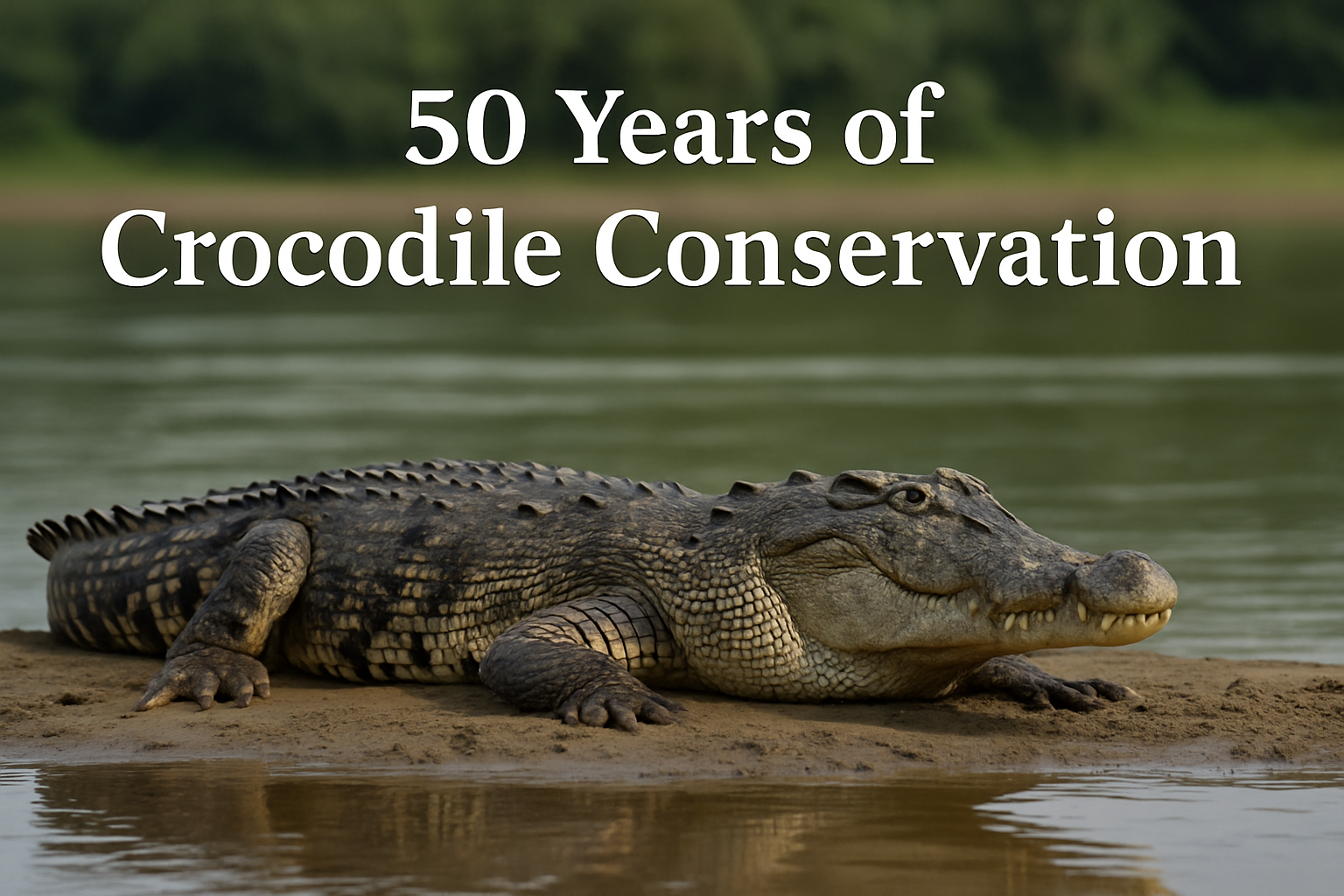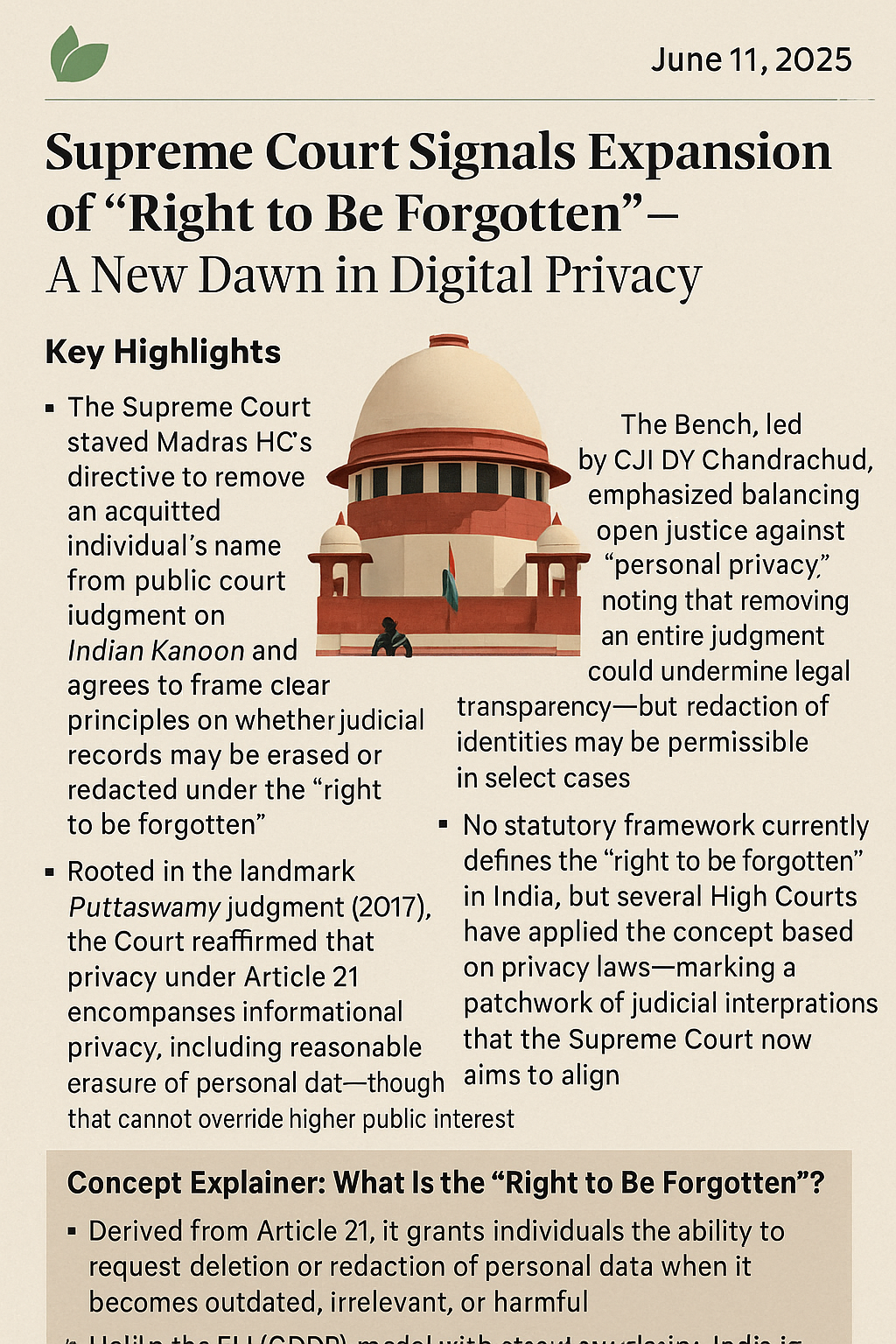
🧭June 21, 2025 Post 1: 🛡️ 50 Years of Crocodile Conservation | High Quality Mains Essay: 50 Years of Crocodile Conservation in India: A Riverine Mirror to Our Ecological Commitments | For IAS-2026 :Prelims MCQs
🛡️ 50 Years of Crocodile Conservation

NATIONAL HERO — PETAL 001
📅Post Date: June 21, 2025
Thematic Focus: Environment | Wildlife Conservation | Species in News
Syllabus Mapping: GS Paper 3 – Environment & Biodiversity
🌿 Opening Whisper
“To protect the crocodile was to protect a river, a rhythm, and a story millions of years old.”
🔍 Key Highlights
- Conservation Milestone: India celebrates 50 years of its Crocodile Conservation Programme, launched in 1975 with FAO and UNDP support.
- Flagship Sites: Three critical centres in Odisha—Bhitarkanika (Saltwater), Similipal (Mugger), and Satkosia (Gharial)—were chosen for early protection and breeding efforts.
- Species Recovered:
- Saltwater Crocodile: ~2,500 in the wild (Bhitarkanika leads).
- Mugger: ~8,000 to 10,000, regaining historical range.
- Gharial: India holds 80% of the global wild population (~3,000), but only ~650 adults.
- Successes & Challenges:
- Establishment of sanctuaries like National Chambal, Katerniaghat, and Son Gharial.
- Gharial still critically endangered despite “head-starting” efforts due to habitat degradation, fishing nets, and pollution.
- Innovations in Conservation:
- Tagging, telemetry, and long-term studies launched post-2008.
- Gharial Ecology Project (GEP) revealed high post-release mortality and stressed need for river ecosystem restoration.
- Ecosystem Emphasis:
- Experts now call for protecting free-flowing rivers, halting sand mining, ensuring genetic diversity, and reducing pollution.
- The core idea: “Saving gharials means saving rivers.”
📘 Concept Explainer: ‘Head-Starting’ Strategy
Introduced in 1975, this involved collecting gharial eggs, hatching them in captivity, and releasing juveniles into sanctuaries. It was globally pioneering but now increasingly viewed as insufficient unless matched by river conservation reforms.
📌 GS Paper Mapping
- GS 3 – Environment: Conservation efforts, habitat preservation, threats to biodiversity.
- GS 3 – Species in News: Gharial, Mugger, and Saltwater Crocodiles.
- GS 3 – Conservation Models: FAO-UNDP supported projects, community-involved conservation.
- GS 3 – Science & Tech in Environment: Tagging, telemetry, hatchery science.
🌀 A Thought Spark — by IAS Monk
The gharial may look ancient, but its fate lies in our modern decisions. Not in hatcheries, but in the health of rivers and the humility of human planning.
High Quality Mains Essay For Practice :
Word Limit 1000-1200
🐊 50 Years of Crocodile Conservation in India: A Riverine Mirror to Our Ecological Commitments
In 1975, India embarked on one of its most ambitious wildlife rescue missions — a comprehensive crocodile conservation programme aimed at reversing the near-extinction of three of the country’s ancient aquatic reptilian species: the saltwater crocodile (Crocodylus porosus), the mugger (Crocodylus palustris), and the critically endangered gharial (Gavialis gangeticus). What began as a desperate response to ecological collapse has become a saga that reflects both the resilience of nature and the evolving consciousness of a nation’s approach to conservation.
A Crisis That Woke a Nation
The early 1970s painted a bleak picture. Surveys by wildlife biologist H.R. Bustard in 1974 revealed that crocodilian populations were teetering on the edge of extinction. Rampant hunting for skins, destruction of nesting habitats due to damming, unregulated sand mining, and growing competition from human activity had pushed the species beyond their thresholds. The gharial, in particular — once a sentinel of the subcontinent’s riverine ecology — had disappeared from 98% of its historical range.
Recognizing the urgency, the Government of India, with technical and financial support from the Food and Agriculture Organization (FAO) and the United Nations Development Programme (UNDP), launched the Crocodile Conservation Project in 1975. Odisha emerged as the flagship state with three pioneering projects dedicated respectively to each species: saltwater crocodiles in Bhitarkanika, muggers in Similipal, and gharials in Satkosia.
‘Head-Starting’ and the First Wave of Conservation
The heart of the early conservation model lay in the “head-starting” strategy — an innovative approach at the time. It involved collecting eggs from the wild, incubating them under controlled conditions, raising juveniles in hatcheries until they were large enough to avoid predation, and then releasing them into protected natural habitats.
Sixteen crocodile rehabilitation centres were established. Sanctuaries like the National Chambal Sanctuary, Son Gharial Sanctuary, Katerniaghat, and Satkosia were set up to house and monitor reintroduced populations. This strategy helped protect the species from immediate extinction and offered space for their slow comeback.
For the saltwater and mugger crocodiles, the results were impressive. Saltwater crocodiles now number around 2,500 in the wild, with Bhitarkanika hosting the densest population. Muggers, the most adaptable of the three species, have reclaimed large parts of their historical range, with current wild populations estimated between 8,000 and 10,000.
The Gharial’s Long Road: Survival But Not Recovery
The gharial, however, presents a paradox. Despite decades of conservation efforts, its adult population in the wild remains stagnant at around 650 individuals. India still holds nearly 80% of the global gharial population, but over 85% of them are confined to a narrow stretch of the Chambal River.
Why has this species, with the most targeted conservation efforts, remained so vulnerable?
Several reasons surface. First, while the head-starting model ensured survival till release, post-release mortality remained alarmingly high. According to data from the Gharial Ecology Project (GEP), survival rates of hatchlings released into rivers were often below 10%, with annual post-monsoon deaths attributed to starvation, entanglement in fishing nets, and shrinking habitats due to sand mining and river modification.
Second, in 2007–08, a catastrophic mortality event wiped out 111 adult gharials in the Chambal River. Necropsies pointed to kidney failure caused by heavy metal toxicity — a glaring symptom of industrial pollution in river ecosystems.
In response, the Madras Crocodile Bank Trust, along with international scientists, launched the GEP to introduce telemetry, tagging, and long-term monitoring — tools that provided real-time insights into gharial behaviour, migration, breeding, and threats.
Challenges Beyond Breeding: Saving Rivers, Not Just Reptiles
Over time, conservationists came to realize that crocodile conservation was no longer just about breeding and release — it was about the integrity of the river ecosystems. Dams, barrages, water diversion, and illegal sand mining had reduced once-mighty rivers into fragmented channels. Nesting sandbanks disappeared, water levels fluctuated unnaturally, and pollution degraded both water quality and food chains.
The Chambal remains the last stronghold for the gharial. Yet even here, upstream activities like illegal sand mining, introduction of invasive fish species, and unregulated fishing threaten the fragile gains made over five decades. In 2024 alone, two radio-tagged gharials died within weeks of their release — caught in fishing nets.
Other rivers such as the Son, Gandak, and Ganga have seen translocation efforts, but they suffer from habitat fragmentation and lack of effective enforcement. A major lesson thus emerges: without large, free-flowing, pollution-free rivers, crocodilian conservation cannot move beyond survival to sustainability.
A Glimmer of Hope: Local Innovations and Global Recognition
Despite setbacks, innovation continues. In 2021, a male gharial translocated to the Son Gharial Sanctuary resulted in successful nesting — a historic first. In the Ganga, more than 20 adult females await male partners, as breeding initiatives expand to other states.
The Crocodile Conservation Programme has also fostered public awareness. Gharials from the Kukrail Gharial Breeding Centre in Lucknow have been sent to countries like Bhutan, Japan, and the USA — enhancing global awareness about India’s native species.
On the global front, India’s crocodile conservation journey has gained recognition. June 17 is now observed as World Crocodile Day. The project itself is often cited as a pioneering example of species recovery through multi-institutional cooperation.
Rethinking the Next 50 Years
Experts now advocate for a shift in strategy — from merely producing and releasing crocodiles to addressing systemic environmental issues:
- River Flow Regulation: Reducing unnatural fluctuations in river levels due to dams and barrages.
- Sand Mining Control: Protecting nesting sites and maintaining sediment balance.
- Fishing Regulation: Banning gill nets in sanctuary zones and promoting sustainable livelihoods for fisherfolk.
- Habitat Connectivity: Ensuring corridors between protected areas to maintain genetic diversity and reduce inbreeding.
- Community Participation: Involving riverside communities in monitoring and protection through education, incentives, and eco-tourism.
- Scientific Monitoring: Expanding tagging, telemetry, and data-driven assessments.
Genetic mixing across gharial populations is also emerging as a priority to reduce the risk of inbreeding and ensure long-term viability. Experts like Sanjeev Kumar Yadav stress the need for site-specific conservation plans, incorporating habitat threat assessments and demographic profiling.
Conclusion: The River Reflects the Nation
As India marks 50 years of crocodile conservation, it faces a philosophical turning point. The gharial — quiet, shy, and ancient — stands not just as a species in danger, but as a mirror to the nation’s rivers. Its struggle for survival is inseparable from the health of our freshwater systems.
The early years of the programme were about numbers — hatchlings released, sanctuaries declared, centres built. The next phase must be about systems — saving sandbanks, securing river flows, banning pollutants, and empowering people. Because crocodiles do not live in isolation. They are indicators — of ecological resilience, of water quality, of humanity’s ability to co-exist.
The gharial has survived, yes. But it has not yet recovered. Whether it does will be a test — not of the species, but of us.
Target IAS-26: Daily MCQs :
📌 Prelims Practice MCQs
Topic: 50 Years of Crocodile Conservation
MCQ 1 – Type 1: How many of the above statements are correct?
Q. Consider the following statements regarding crocodile conservation in India:
1. India is home to three crocodilian species: the mugger, the saltwater crocodile, and the gharial.
2. The Chambal River is the only Indian river where gharials have ever successfully bred in the wild.
3. The “head-starting” strategy was focused on raising juveniles in captivity until they are safe from predators before releasing them.
4. India holds over 80% of the world’s wild gharial population today.
How many of the above statements are correct?
A) Only two
B) Only three
C) All four
D) Only one
🌀 Didn’t get it? Click here (▸) for the Correct Answer & Explanation
✅ Correct Answer: B) Only three
🧠 Explanation:
1) ✅ True – These are the three species conserved under the 1975 programme.
2) ❌ False – Although Chambal is the major breeding site, other rivers like the Son and Ganga have also seen successful nesting recently.
3) ✅ True – This is the key element of the 1975 conservation programme.
4) ✅ True – India holds around 80% of the global wild gharial population.
MCQ 2 – Type 2: Two Statements Based
Q. Consider the following two statements:
1. Gharials are listed as “Endangered” on the IUCN Red List.
2. The Crocodile Conservation Project in India was launched in collaboration with FAO and UNDP.
Which of the above statements is/are correct?
A) Only 1 is correct
B) Only 2 is correct
C) Both are correct
D) Neither is correct
🌀 Didn’t get it? Click here (▸) for the Correct Answer & Explanation
✅ Correct Answer: B) Only 2 is correct
🧠 Explanation:
1) ❌ False – Gharials are listed as Critically Endangered, not merely “Endangered”.
2) ✅ True – The project began in 1975 with assistance from FAO and UNDP.
MCQ 3 – Type 3: Which of the statements is/are correct?
Q. Which of the following are challenges still affecting the conservation of gharials in India?
1. Low hatchling survival rate in the wild
2. Pollution and toxic substances in rivers
3. Illegal sand mining in nesting zones
4.High success rate of male translocation
Select the correct code:
A) 1, 2, and 3 only
B) 1 and 4 only
C) 2, 3, and 4 only
D) All four
🌀 Didn’t get it? Click here (▸) for the Correct Answer & Explanation
✅ Correct Answer: A) 1, 2, and 3 only
🧠 Explanation:
1) ✅ True – Gharial hatchlings suffer over 90% mortality in some years.
2) ✅ True – The 2007–08 mass deaths were due to kidney damage from toxins.
3) ✅ True – Sand mining affects nesting banks.
4) ❌ False – While translocations are increasing, high success is not yet achieved.
MCQ 4 – Type 4: Direct Fact
Which Indian state hosts conservation sites for all three crocodilian species?
A) Madhya Pradesh
B) Odisha
C) Uttar Pradesh
D) West Bengal
🌀 Didn’t get it? Click here (▸) for the Correct Answer & Explanation.
✅ Correct Answer: B) Odisha
🧠 Explanation:
• Odisha is the only state that hosts all three crocodile species: saltwater (Bhitarkanika), mugger (Similipal), and gharial (Satkosia).


















